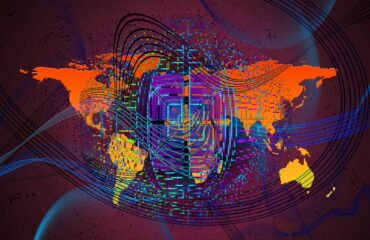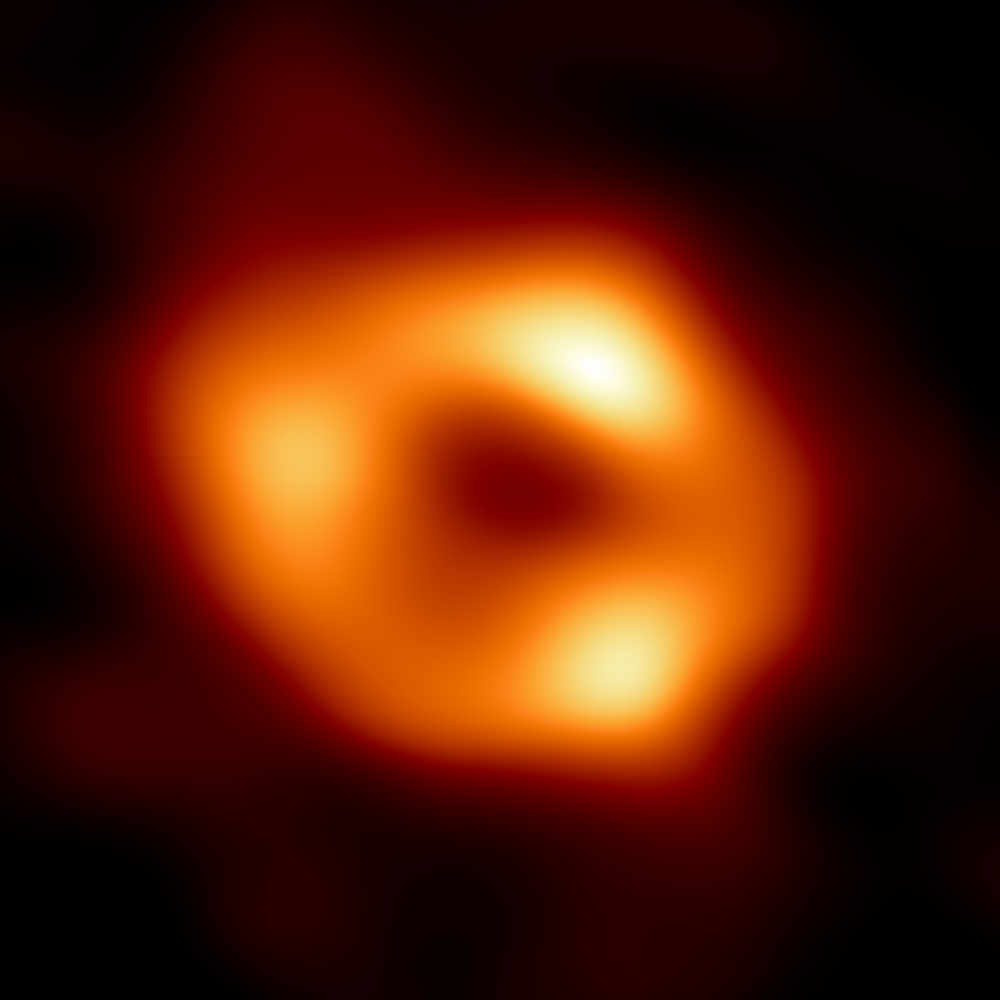
The first-ever image of radio frequency photons of energy at the boundary of the black hole at the centre of the Milky Way. Image: Event Horizon Telescope.
By James Myers
“Quantum mechanics is certainly imposing. But an inner voice tells me that it is not yet the real thing. The theory produces a good deal but hardly brings us closer to the secret of the Old. I am in any event convinced It does not roll dice.” – Albert Einstein in a letter to Max Born,1926
“Die Quantenmechanik ist sehr achtung-gebietend. Aber eine innere Stimme sagt mir, daß das doch nicht der wahre Jakob ist. Die Theorie liefert viel, aber dem Geheimnis des Alten bringt sie uns kaum näher. Jedenfalls bin ich überzeugt, daß der nicht würfelt.” (In the original German, nowhere did Einstein use the word “God” or “He” which were added in later translations.)
In the 97 years since Einstein’s famous letter to physicist Max Born, stating his belief that quantum mechanics operate on principles of order rather than in random probabilities, we have learned a great deal more about the physics of the universe.
The fundamental nature of quantum mechanics is still, however, heavily debated, although we now understand that every physical thing in existence is made of quanta (singular: quantum) of energy.
Rapidly advancing technology that uses the quantum for data transmission in the incredibly fast quantum computer provides many new reasons to solve the questions of quantum mechanics’ fundamental nature. There is also an urgent need to increase understanding of quantum operation in order to find a solution to the looming quantum cryptography crisis, which threatens to break data encryption as the power of the quantum computer multiplies and nears the potential of widespread commercial use.
Einstein’s questioning of the “real thing” (he used the term “true Jakob”, like we would say “the real McCoy”) in the quantum realm remains unanswered, after nearly a century of incredible technological advances powered in no small measure by Einstein’s theory of general relativity. The real thing hasn’t been found yet in the physics of space and time, but is it possible the answer might lie beyond – in that which isn’t part of space and time, in the black hole?
Technology has allowed us to measure much about the quantum and its effects in space and time
Operating without resistance at the speed of light, the energy that makes up each of us and the entire fabric of space and time (“spacetime”) is fundamentally composed of quanta. The quantum is the smallest measurable amount of energy that can cause change or be changed. Mass, which consists of energy as Einstein’s famous E=mc2 demonstrates, can be thought of as bundles of quanta in varying amounts that cause the fabric of spacetime to curve. We have so far been unable, however, to determine the fate of quanta after they encounter the boundary of a black hole, where the fabric of spacetime ends.
The speed of light, which is the rate that quanta fly around forming bundles of mass in spacetime, can be thought of as the ratio of the distance that quanta can occupy over three dimensions of space always divided between two points in time. We know of no limit to time itself, but any event occupies two points in time – one point of time at the beginning of the event and its opposite point at the end of the event. Technology continues to deliver new and increasingly accurate methods of measuring time, but time appears to “dilate” by losing its beginning and end as quanta approach the boundary of the black hole at near light-speed.
Another way of saying “ratio of distance to time” for light-speed is the “difference”, or “fraction”, of distance (in the numerator) divided by time (in the denominator). It’s therefore the case that quanta of energy forming any event represent fractions of all energy, combining over the distance of three points in space and dividing between two points in time. The problem remains that the rapidly increasing power of our technology has not yet been able to pinpoint the source of all fractions of energy in space, all events in time, and the origin of quanta of energy.
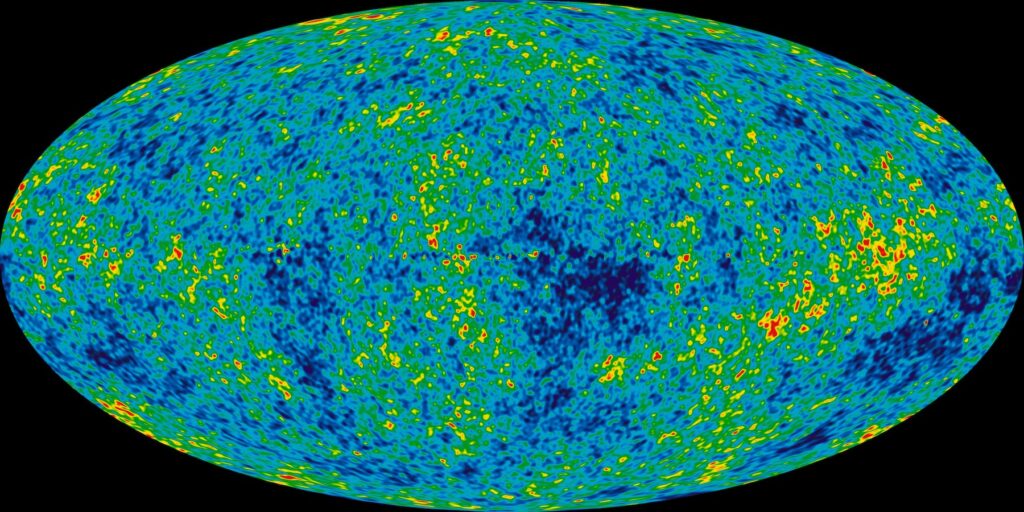
The cosmic microwave background, 13.5 billion light years away – the furthest our technology will measure. Image: Wikipedia
We have theories, but lack proof and a means of unifying our understanding of quantum mechanics with the gravity of spacetime curvature in Einstein’s theory of general relativity.
The big bang theory is a widely-accepted conjecture for the source of space and time. Although the effects of a sudden explosion of curved spacetime in a “big bang” can be observed in the cosmic microwave background, which is detectable at a distance of about 13.5 billion light years from Earth, the big bang lacks a source. Other conjectures, like the big bounce, might be theoretically possible but lack observable evidence because our technology cannot see beyond the cosmic microwave background.
Is the way that energy operates in fractions a reason, in a sense, for humanity’s age-old interest in exploring the cosmos? It’s clear to see that we exist as fractions of the universe’s energy, each with our own limits in time as everyone is born and everyone dies. While we live, do we seek the source of energy itself, and therefore the cause of all of its fractions, ourselves included?
The search for the hidden cause of everything motivated Einstein’s thinking expressed in his letter to Max Born. Particularly striking in Einstein’s words are “dem Geheimnis des Alten”, properly translated as “the secret of the Old,” and which was not a reference to God. It is a foundation of scientific knowledge that the universe is the first and therefore oldest thing in existence. In imagining the cause of spacetime as the universal structure, Einstein would have been especially aware that the universe is the oldest of all, and thus he used the words “des Alten” in writing to Born about the mystery of the quantum. For Einstein, the secret was to be found at the beginning of time, not space.
Is it to seek the ultimate cause that humanity continues to invest significant time and energy in the quest for knowledge of the cosmos?
This edition of The Quantum Record highlights many ways we are applying our technology to the search – in looking for planets with water that could sustain life, seeking the cause of high-altitude “space hurricanes,” detecting and deflecting asteroids to defend Earth, learning about the sun’s flares and CMEs, peering into the earliest galaxies with the power of the James Webb Space Telescope, preparing for another human landing on the Moon, and examining the finest details of matter using the most brilliant synchotron light of the universe.
If it’s not the cause of it all that we’re seeking, what else is it?
The order of time is not random, but how do we find the order of cause and effect?
If time is to have any meaning, as it seems to do for each of us in our own way, events in time cannot be random. If events occurred randomly, our conscious actions would be inconsequential. We would be unable to act as a cause, or to judge the effects of our actions, if events were random.
Has science proven any event to be purely random, beyond any doubt? We might think that some events occur based on probability alone, but the ongoing debate on quantum mechanics shows that probability is not yet an agreed basis for events in the universe. Our knowledge continues to evolve. Take, for instance, Brownian motion of particles suspended in a medium such as gas or liquid: it was thought to be random until Einstein’s 1905 paper that set out the logic and cause for the motion. Curiously, it was his insight into Brownian motion that won Einstein the Nobel Prize, not his discovery of general relativity.
An event in time consists of either an increase or a decrease in numbers of quanta in combination. Although the differing increases and decreases result in the curving of space in the fabric of spacetime, all events in time occur in a single order. In time, an event always has a beginning, which is the cause and start of the event, and then proceeds to an ending, which is the effect of the event. Sequences in time from one moment to the next always begin with the cause and end with the effect.
Since events cannot be random, and the sequences that place the present in the middle of past and future must operate without interruption, the beginning of each event must connect to the end of another event. Imagine events as if they are in a chain, always with the sequence of cause and effect from beginning to end and the present occupying the space in between. We might also think of cause and effect like the connection between input and output in a computer algorithm, in that you can never receive an output without having first input something to its function.
Many questions remain about the operation of cause and effect in quanta, whose outcomes in time appear to be affected by the act of measurement in what is called the “observer effect.” What is the cause of quantum motion, and how can their effects be measured? Do quanta operate individually in particles of light, or combined in waves of probability, or both? Does observation cause a collapse of energy waves, stopping the quanta that comprise the waves dead in their tracks – or does observation divert the quanta?
The Quantum Record recently featured the work of Dr. Vlatko Vedral who, like many scientists, is proposing ways of re-thinking quantum mechanics to unify it with the principles of Einstein’s theory of general relativity. Dr. Vedral is re-imagining the concept of time in quantum mechanics as something that is relative and subject to bending, just as time operates in the physical fabric of spacetime. A significant change from the most-frequently applied concept of time in quantum mechanics as a series of steps of fixed lengths, this may lead to a greater understanding of what happens to quanta at the boundary of black holes.
Technological feat opens new horizons and possible answers.
One point in the universe that might yield a significant amount of new information on quantum mechanics is the black hole around which our galaxy rotates. The first-ever image of the boundary of the black hole in the middle of the Milky Way was taken in 2017, and required 5 years to process the average of its data before it was published by the Event Horizon Telescope (EHT) in 2022. That boundary, where quanta of energy in the fabric of spacetime end and some other process begins, may yield the clues we need to unlock the secrets of the quantum.
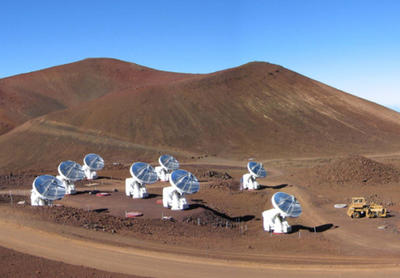
The Submillimeter Array telescope in Hawaii is part of the Event Horizon Telescope global array. Image: EHT
In existence since 2009, the EHT is an international collaboration with a global array of radio telescopes. They have the combined power to see 26,000 light years to the centre of the galaxy, by following the path that light took at the rate of 299,792,458 metres per second over 26,000 years before it arrived at Earth. The spectacular feat of the EHT was accomplished using the technology of very-long baseline interferometry, which allows many independent radio antennas separated by hundreds or thousands of kilometres to act as one, with an effective aperture for receiving radio signals equal to the diameter of the Earth.
Thanks in no small measure to Einstein’s famous theory of general relativity, human technology has developed to the point that we are now able to witness the boundary of the supermassive black hole at the centre of our Milky Way galaxy.
With a mass over 4 million times that of our Sun, this black hole has been named ‘Sagittarius A*’ (the * is read as “star” and the name can be abbreviated as Sgr A*). The boundary of Sgr A* is where the Milky Way’s fabric of space and time ends, and where the observable laws of physics seem to cease functioning.
What the Event Horizon Telescope saw in 2017 at the centre of the Milky Way is a supermassive black hole. Sagittarius A* has such a massive gravitational attraction that it captures an array of stars, gas, and dust in its orbit, demonstrating the curvature of the fabric of spacetime that was defined in the mathematics and geometry of Einstein’s theory of general relativity 102 years earlier, in 1915. By measuring the gravitational field of the black hole against a star orbiting at an unbelievably fast 25 million kilometres per hour, in 2018 scientists at the European Southern Observatory (ESO) and their collaborators proved Einstein’s general relatively right – yet again – but “in a more extreme laboratory that he could have possibly imagined.”
Black holes like Sgr A*, first detected in 1954 by the strength of its radio waves and proven to exist by the work of Roger Penrose, Reinhard Genzel, and Andrea Ghez (the three were awarded the 2020 Nobel Prize in Physics), are by no means unique.
We have used our technology to establish that there is a black hole at the centre of every galaxy, and their properties appear to defy the imagination. With masses often millions of times greater than the Sun, which is largest object in our solar system, black holes are relatively compact in size. Although Sgr A* is estimated to have a diameter of 52 million kilometres, it is dwarfed on the cosmic scale by comparison to its distance from Earth which is 26,000 light years (9.45 trillion kilometres).
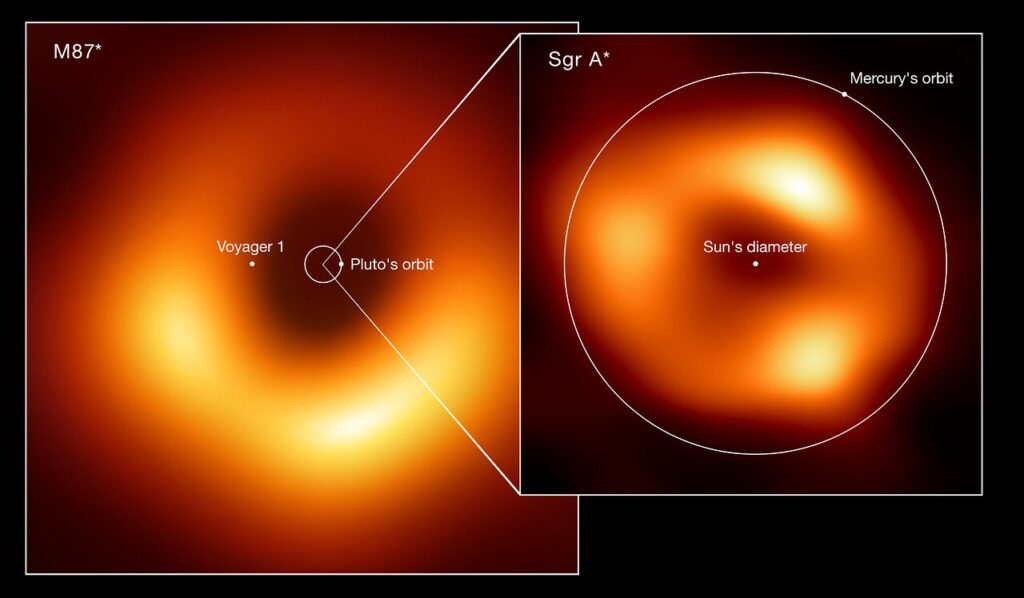
The compact size of two black holes imaged by the Event Horizon Telescope – M87* and our Milky Way’s Sgr A* – is demonstrated with reference to our Sun and the extent of Mercury’s orbit around our Sun. Image: European Southern Observatory.
Why Do We Pursue the Truth of Black Holes?
What more will we learn as our technology continues to peer with increasing precision at objects like Sgr A* that have no space and no time, and as we measure the reactions of the surrounding fabric of spacetime? How much more will we spend on the continuous improvement of technology to advance our understanding of the cosmos and its tiniest constituent, the quantum, and how will the knowledge we gain affect our future?
Why do scientists like Dr. Vedral pursue the truth of black holes, the boundaries of which do not permit the passage of light and are therefore impenetrable to observational technology? How will the scientific method be applied to something that is not subject to empirical proof, when it seems we are limited to observing only its effects on the surrounding environment and not the black hole itself?
Scientists have reason to doubt that tiniest-scale quantum reality can even be revealed by studying an object at the largest scale, like a black hole. When the first image of the black hole at the centre of the distant M87 galaxy was presented in 2019, physicist and cosmologist Janna Levin said, “Can we really understand the hard stuff, like what’s going on at the quantum level at the event horizon? That’s not likely with this data. Most astrophysical black holes are too big to really be exploring their quantum side.”
The full range of universal complexities, from the tiny quantum to the most massive black holes, has so far defied our most advanced technology. But will time soon take a new path, as technology continues to improve our ability to measure cause and effect in the cosmos?
Measuring Cause and Effect
Maybe the secret of the quantum is fundamentally the connection of cause and effect, which Einstein’s inner voice told him could not be random. As Jim Baggott wrote in an Aeon Magazine feature,“Einstein could not accept an interpretation in which the principal object of the representation – the wave function – is not ‘real’. He could not accept that his God would allow the ‘lawful harmony’ to unravel so completely at the atomic scale, bringing lawless indeterminism and uncertainty, with effects that can’t be entirely and unambiguously predicted from their causes.”
- Image: johnhain (Pixabay)
Einstein’s reference to rolling of dice described random, unpredictable results.
Empirical evidence continues to deliver no proof of randomness in the universe. Isaac Newton’s second law of motion, that for every physical action there is an equal and opposite reaction, seals the connection of cause and effect in the fabric of spacetime.
Where cause and effect may or may not exist, however, is in the middle of a black hole. We have now seen to the boundary of the black hole, and how soon – if ever – will our technology be able to measure what’s inside it?
If we find a means to measure what lies beyond spacetime, in the black hole, what will the measurements tell us about the cause and effect of quanta in spacetime? Will they bear out Einstein’s inner voice and prove his conviction that the Old does not roll the dice, or will they show that what appear to be consequences of our actions are only illusions in a universe that is ultimately random and without order?
One consequence, should we succeed in piercing the veil of the black hole to gauge what’s inside, may well be a revision to our methods of measurement. Any measurement we now make assumes that space and time are all that exists to measure, but what will change if we discover that measurement extends beyond space and time and into the black hole? Technology may soon bring the question of measurement to the forefront, and with it a host of new questions and knowledge of cause and effect in time.



